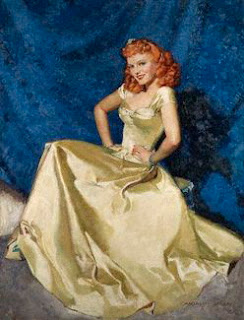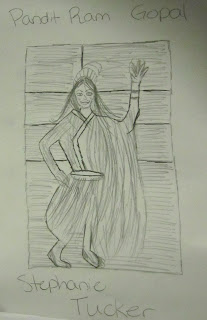The logo for the Tate Britain uses sans serif font. Both words are in all capital letters. The font for Tate is thicker and sporadic. It does not have clean cut lines and looks fleeting and ghostly. The font for Britain is clean and simple with thin, even letters. The word Britain is off-center and to the top right of the word Tate. I like the logo. I think it is interesting because it looks like a font for a horror movie. I would not expect the font for an art museum to be ghostly, uneven, thick and hard to read. But because it is unexpected, it catches my attention. I think the logo reflects much of the art in the museum by being unique and initially hard to discern, requiring further inspection. The logo adds to the mystery and intrigue of what one may find in the museum.
 |
| From "Museums: Branding and History" |
Ophelia's death in John Everett Millais' painting is tranquil and beautiful. Ophelia is wearing a gown and is holding a flower in her hand. She looks as though she is sleeping, floating on the water and allowing the current to carry her away. She is surrounded by lush vegetation, including flowers, grasses and trees. She does not appear crazy or under duress. In the painting, there is no indication that Ophelia has been harmed or is even dead. The top of the painting has rounded corners, adding to the tranquility of the scene.
On the other hand, in Director Nicholas Hytner's Hamlet, Ophelia went mad before she died. She is not wearing a fine dress, in fact, she isn't even wearing a complete outfit. She dances around on stage without a shirt and singing. Ophelia is eventually brutally dragged off by the police and murdered. When she is dragged away, she begins screaming and is extremely frightened. The painting does not in any way depict the scene from Hytner's Hamlet.
It is possible this is the most popular painting in the collection because people like happy endings. They enjoy thinking about and seeing the painting's interpretation over facing the reality of the scene.



The first two pictures are of the modern art gallery and the third illustrates salon style hanging. The modern gallery had white walls and minimalist paintings. It was cold and boring. A huge room only held seven pieces because there was two to three painting spaces between each work. The room with the modern art had hardwood floors and a plain ceiling. The lights were simple bulbs with silver casings and were lined up in a row on the ceiling. Each painting only contained a few muted colors including yellow, brown and beige. The brown benches in the center of the modern gallery were slightly more ornate in style, but were still boring featuring dark wood and dark brown leather. The ropes keeping people away from the paintings were thin white ropes stretched between a thin silver stand.
The salon style gallery had a warmer feel. All of the paintings were clustered together on blue walls. There was more lighting in the room and thick moldings along the floor. When I peeked into the salon style room, I didn't know where to look. My eyes kept darting from the ceiling to the molding and then to the paintings. In the minimalist gallery, I ran out of items to look at. The paintings in the salon style room contained portraits. The frames on the paintings were ornate and thick, adding to the chaos of the room. Because the paintings were so close together it was almost impossible to look at only one at a time. Instead, I viewed them more by clusters. I thought the salon style gallery was more interesting and inviting.

"The Coral Reef" by Mike Nelson was an interesting exhibit because it wasn't traditional painting or sculpture. It was a series of rooms, many of which had multiple doors, that depicted scenes devoid of any human life. One room contained two televisions displaying static, giving the illusion they had been left in a hurry or something had gone wrong. Another room had a lamp and a couch. The exhibit was creepy and haunting. It felt as though I was walking through a disaster zone or the aftermath of some terrible disaster. I felt like I shouldn't be there and I should be escaping as well. Many of the rooms smelled like old wood and felt dirty and damp. The doors to many of the rooms creaked and slammed shut behind me. It was hard to find my way through the exhibit because I kept returning to rooms I had already seen or hallways I recognized. However, I found the exhibit very interesting. I had never before experienced something like that. I think the exhibit is art because it is an artist's interpretation and subsequent illustration of that message. It expresses the artist's feelings about a particular topic. On the plaque outside the exhibit, Nelson states that he wants people to feel "lost in a world of lost people" and I definitely felt lost inside the exhibit.
I liked the Tate Britain more than the V&A because I found the exhibits more interesting. The Tate Britain surprised me with every subsequent room. The art was unique and unexpected. There were a few expected paintings of landscapes or people, but many of the paintings were abstract and depicted unique scenes. The works of art at the Tate Britain were filled with bright colors and weird shapes, whereas much of the art in the V&A was stone or iron. At the V&A, although many of the objects were impressive, they were what I expected to see when I was told I was seeing cast courts or ironworks. But at the Tate Britain, I did not know what I would see in the next room. However, I found the building and the architecture of the V&A more impressive than the Tate Britain. The outside of the V&A was larger and grander and the lobby featured a gorgeous Chihuly sculpture. The outside and inside of the Tate Britain was more understated and plain. But I felt like this allowed visitors to focus more on the objects inside the museum without being distracted by the surrounding building. I also felt that the Tate Britain was easier to navigate. The rooms on the map were numbered and the exhibits I visited were all on one level. The galleries were open and generally rectangular. The V&A had a lot of twists and turns and I had to take specific staircases to reach certain exhibits. I thought the Tate Britain was overall a more interesting experience.

 |
| The third portion |
 |
| A face from the fourth portion |
This painting is called "The Autobiography of an Embryo" by Eileen Agar from 1933-4. The painting is split into four parts. I thought it was interesting because without knowing the title, I would have had no idea what this painting depicted. But after reading the title, I was able to start to see the different stages of embryonic development loosely portrayed in the painting. The painting mixes abstract shapes with discernible figures and fiction with reality. The first portion of the painting has alien-like figures, fish and a circular motif running through many of the objects in the first portion. I believe the alien-like figure symbolizes the inability to recognize a human form in the initial stages of development and the fish stands for the water surrounding human embryos. The second portion features multiple figures of people, which could be illustrating the possibility that this embryo could become any type of person. The third portion has birds, horns, a headdress, a womb with a baby inside and mummies. This could be the preparation for birth and a new life mirrored with death: the circle of life. The fourth portion is brighter and facial expressions and eyes can be seen on some of the figures' faces. There are also explosion-like images and shapes, which could represent the birth.
I enjoyed this work of art because it was fun to try and imagine what Agar was thinking while painting the work. Because it was partly abstract and contained four parts, it held my attention for a long time and each second I found something I had not seen a second before.


































